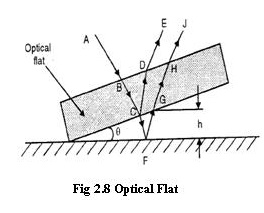Chapter: Mechanical : Metrology and Measurements : Linear and Angular Measurements
Interfero Meters
INTERFERO METERS
They are optical instruments used for
measuring flatness and determining the length of the slip gauges by direct
reference to the wavelength of light. It overcomes the drawbacks of optical
flats used in ordinary daylight. In these instruments the lay of the optical
flat can be controlled and fringes can be oriented as per the requirement. An
arrangement is made to view the fringes directly from the top and avoid any
distortion due to incorrect viewing.
Optical Flat and
Calibration
1.
Optical flat are flat lenses, made from
quartz, having a very accurate surface to transmit light.
2. They
are used in interferometers, for testing plane surfaces.
3.
The diameter of an optical flat varies
from 50 to 250 nun and thickness varies from 12 to 25 mm.
4. Optical
flats are made in a range of sizes and shapes.
5. The
flats are available with a coated surface.
6.
The coating is a thin film, usually
titanium oxide, applied on the surface to reduce the light lost by reflection.
7.
The coating is so thin that it does not
affect the position of the fringe bands, but a coated flat. The supporting
surface on which the optical flat measurements are made must provide a clean,
rigid platform. Optical flats are cylindrical in form, with the working surface
and are of two types are i) type A, ii) type B.
i)
Type A:
It has only one surface flat and is used
for testing flatness of precision measuring surfaces of flats, slip gauges and
measuring tables. The tolerance on flat should be 0.05 µm for type A.
ii)
Type B:
It has both surfaces flat and parallel
to each other. They are used for testing measuring surfaces of micrometers,
Measuring anvils and similar length of measuring devices for testing flatness
and parallelism. For these instruments, their thickness and grades are
important. The tolerances on flatness, parallelism and thickness should be 0.05
µm.
Interference Bands by
Optical Flat
Optical flats arc blocks of glass finished to within
0.05 microns for flatness. When art optical flat is on a flat surface which is
not perfectly flat then optical flat will not exactly coincide with it, but it
will make an angle e with the surface as shown in Figure 2.8.

Related Topics